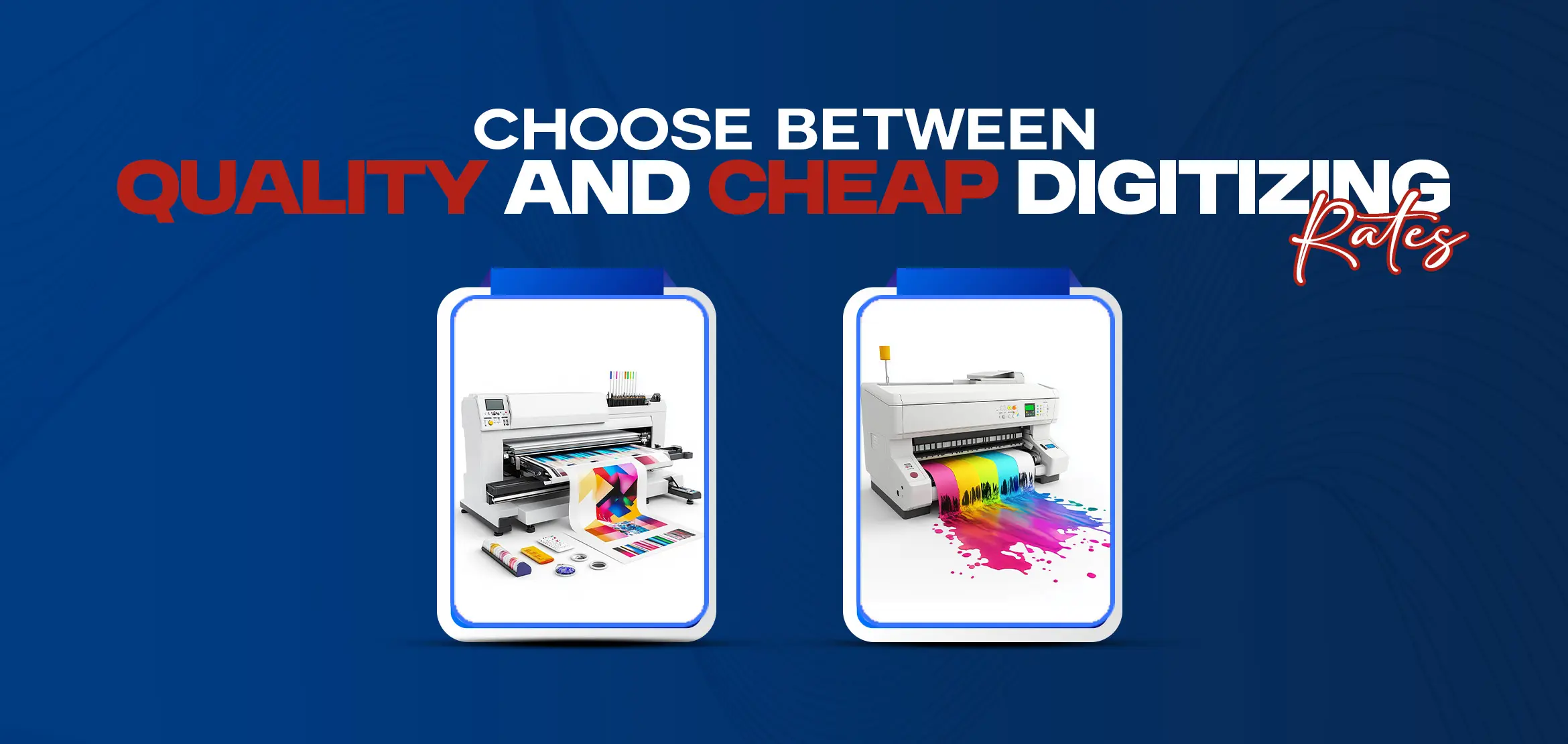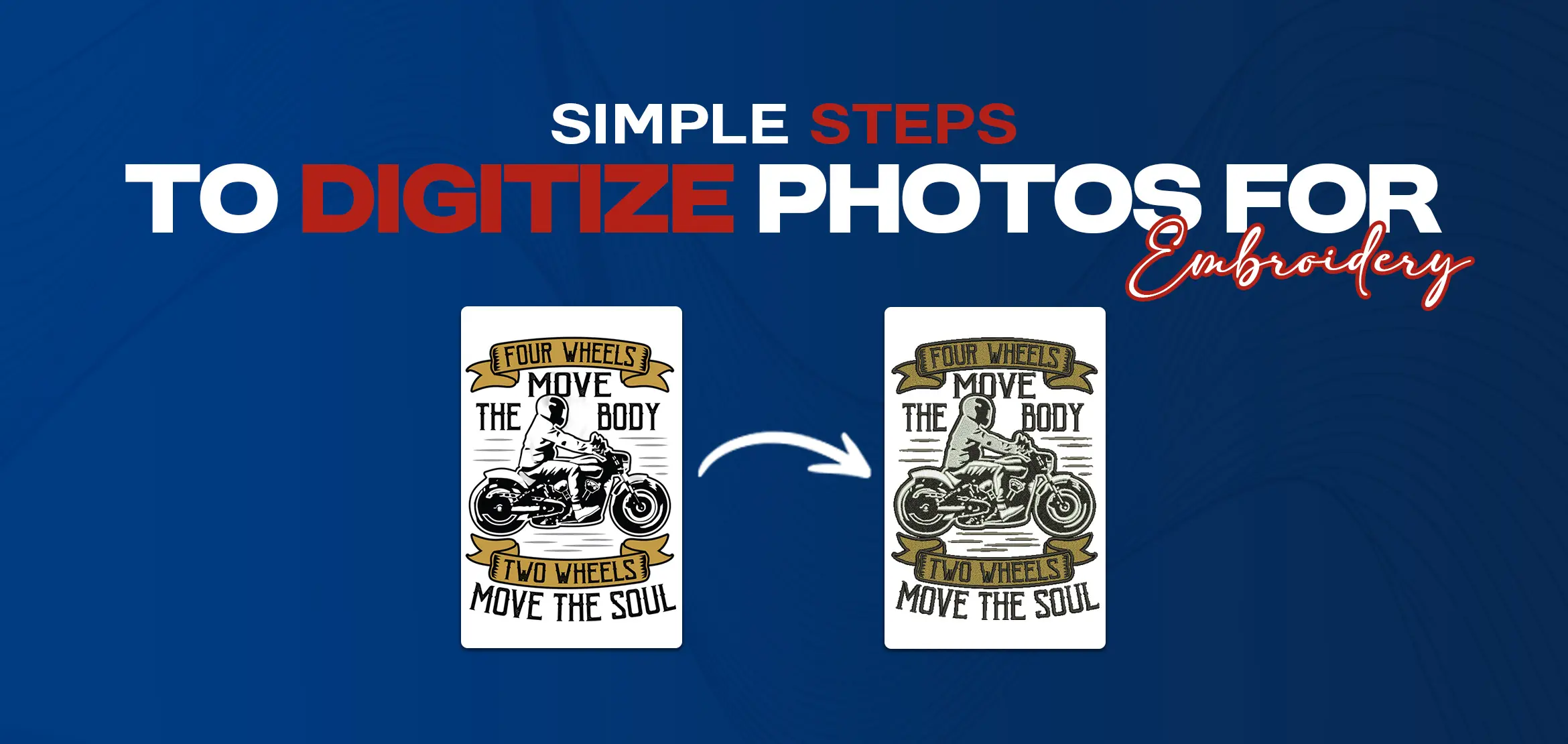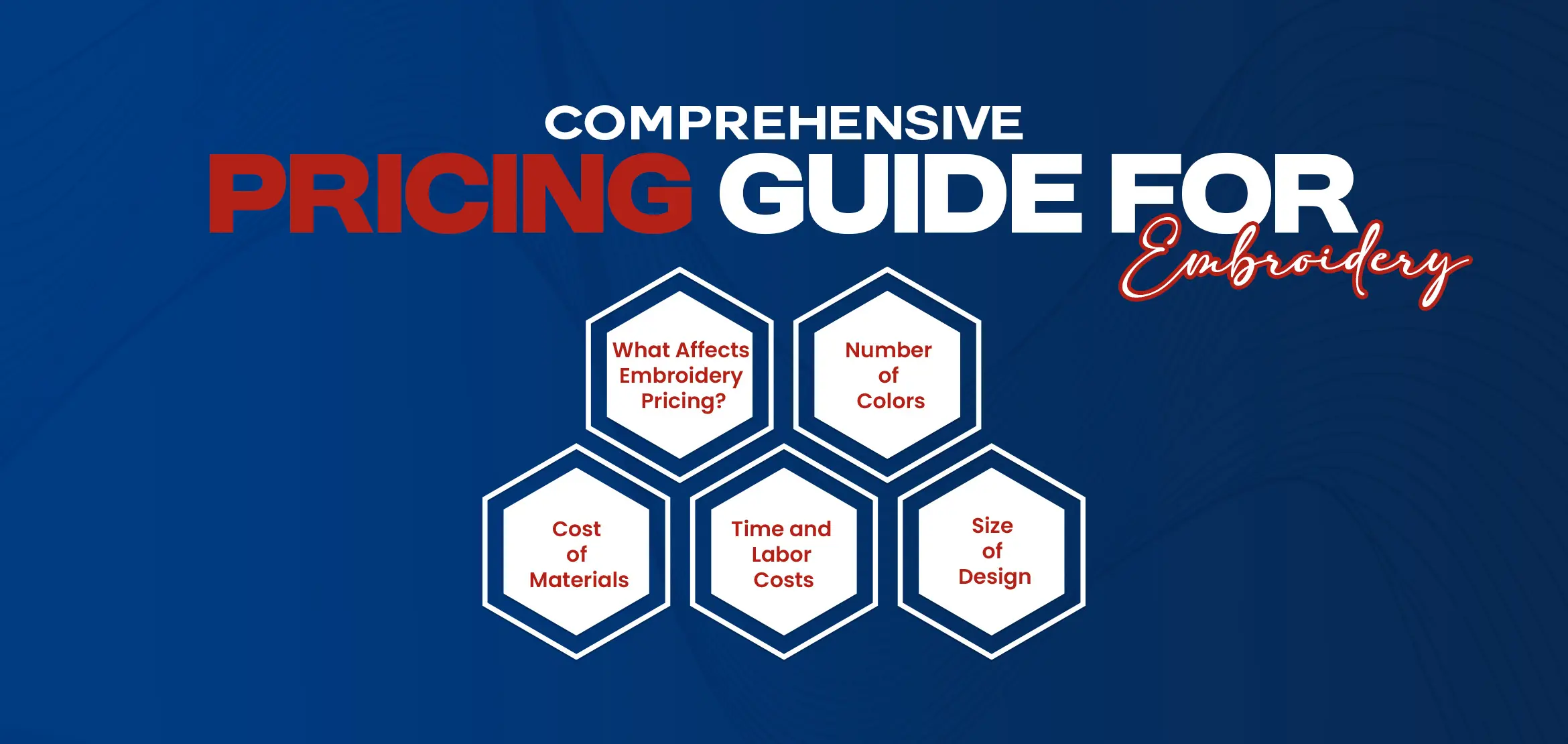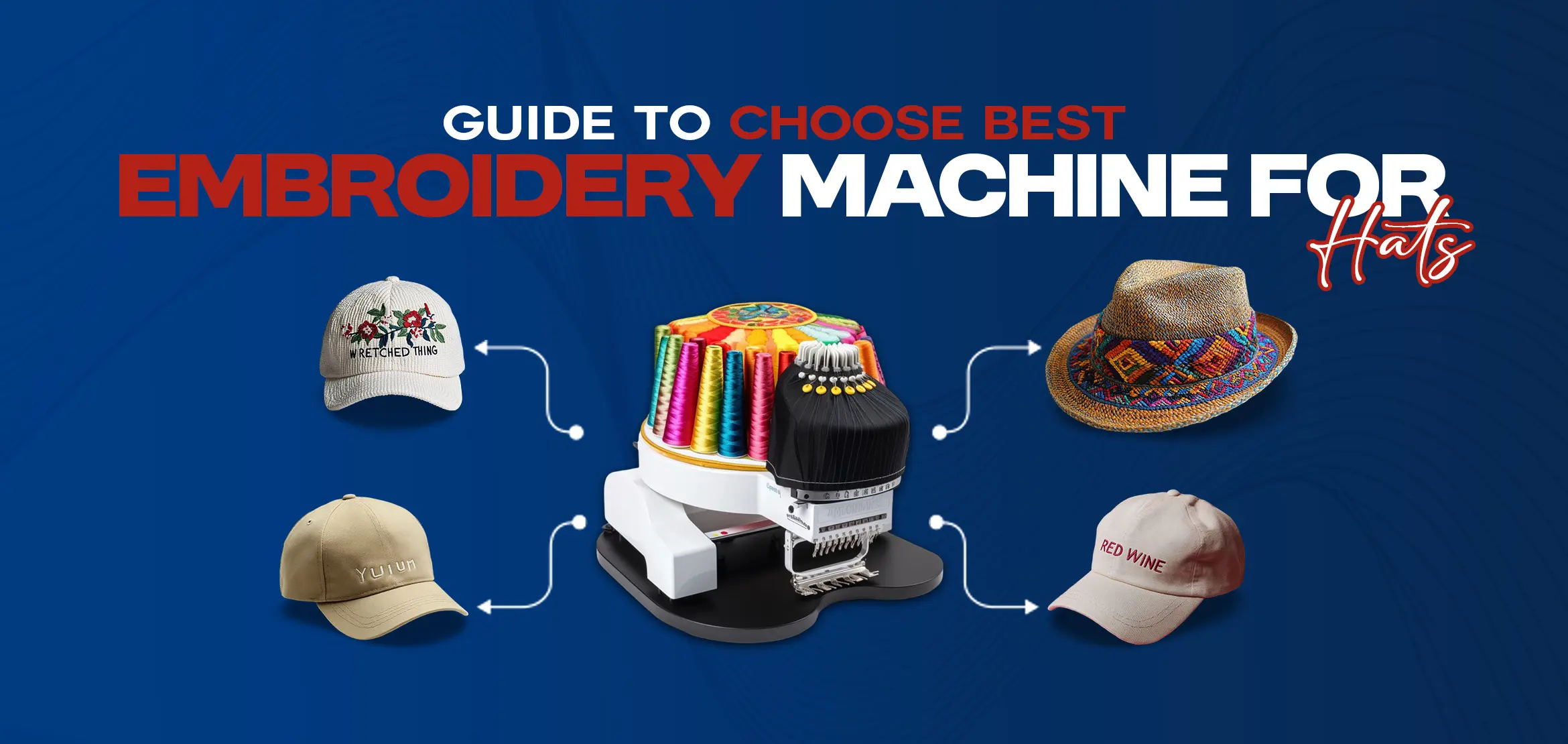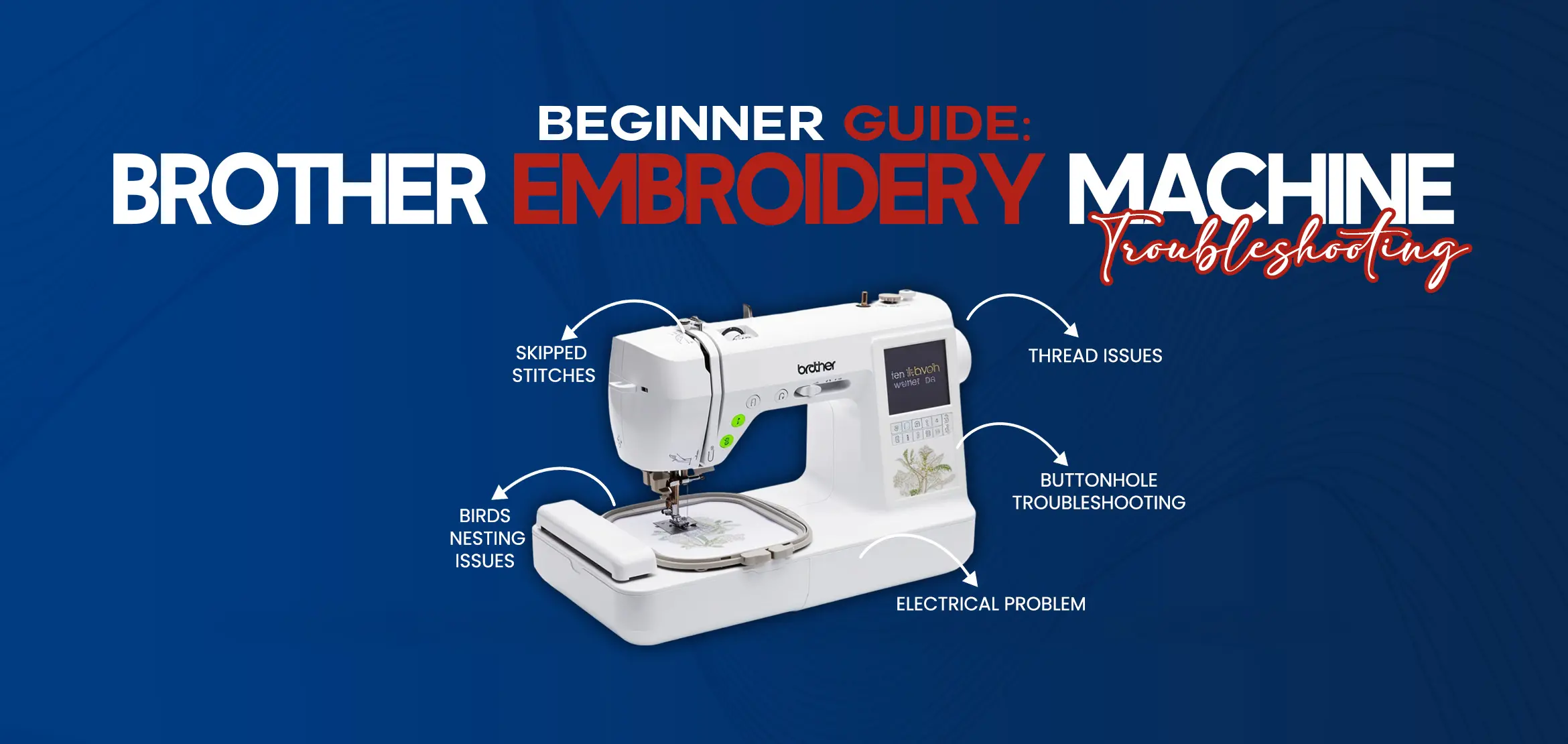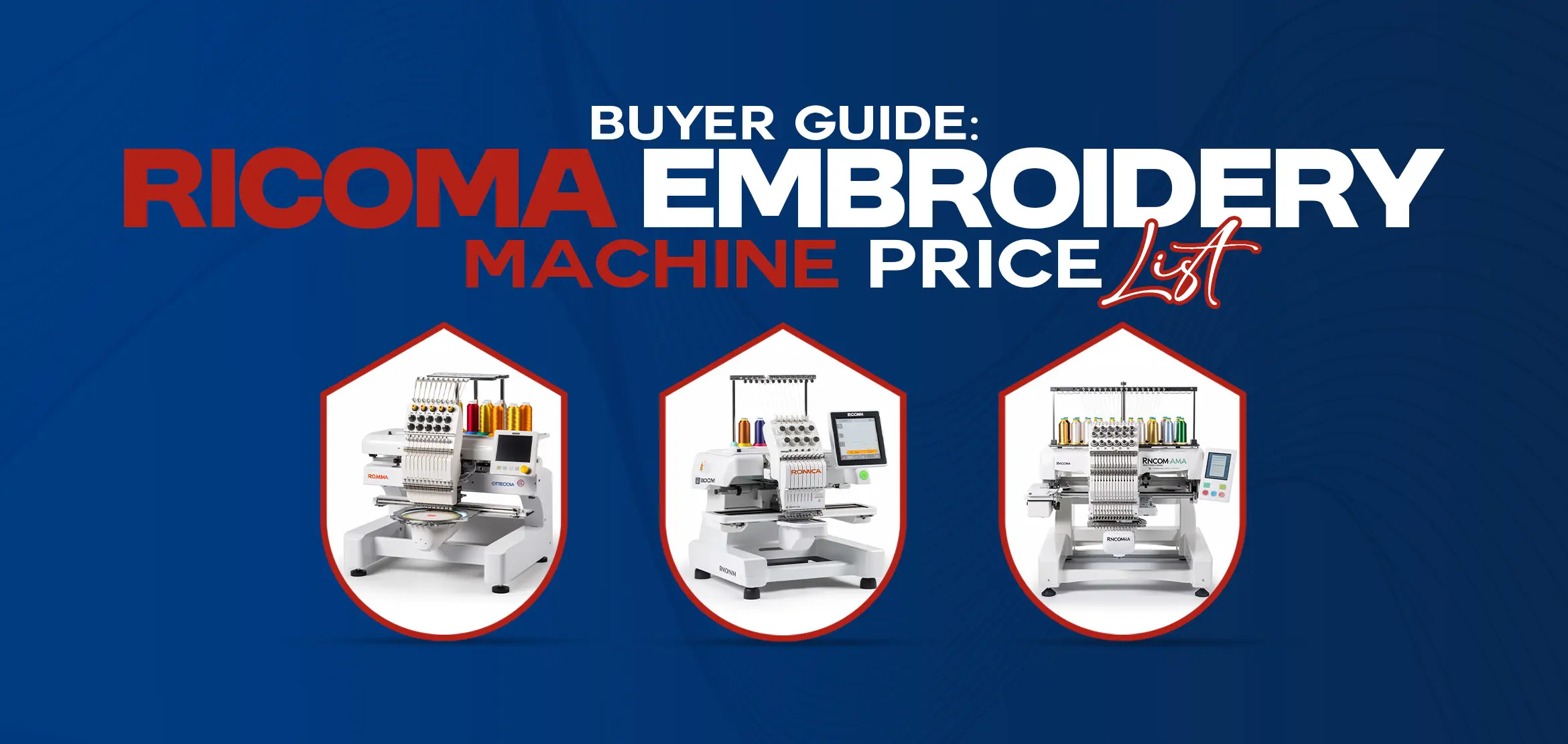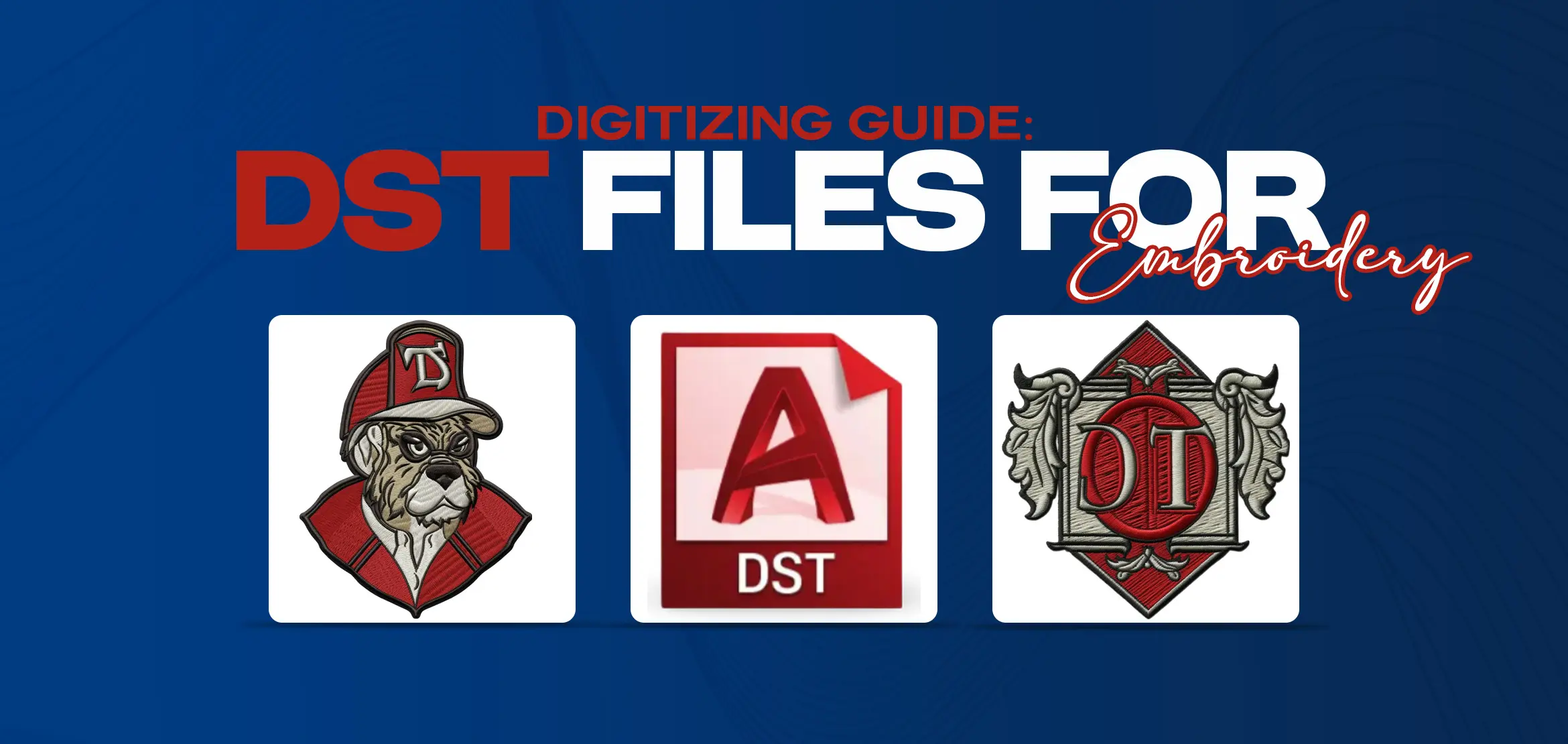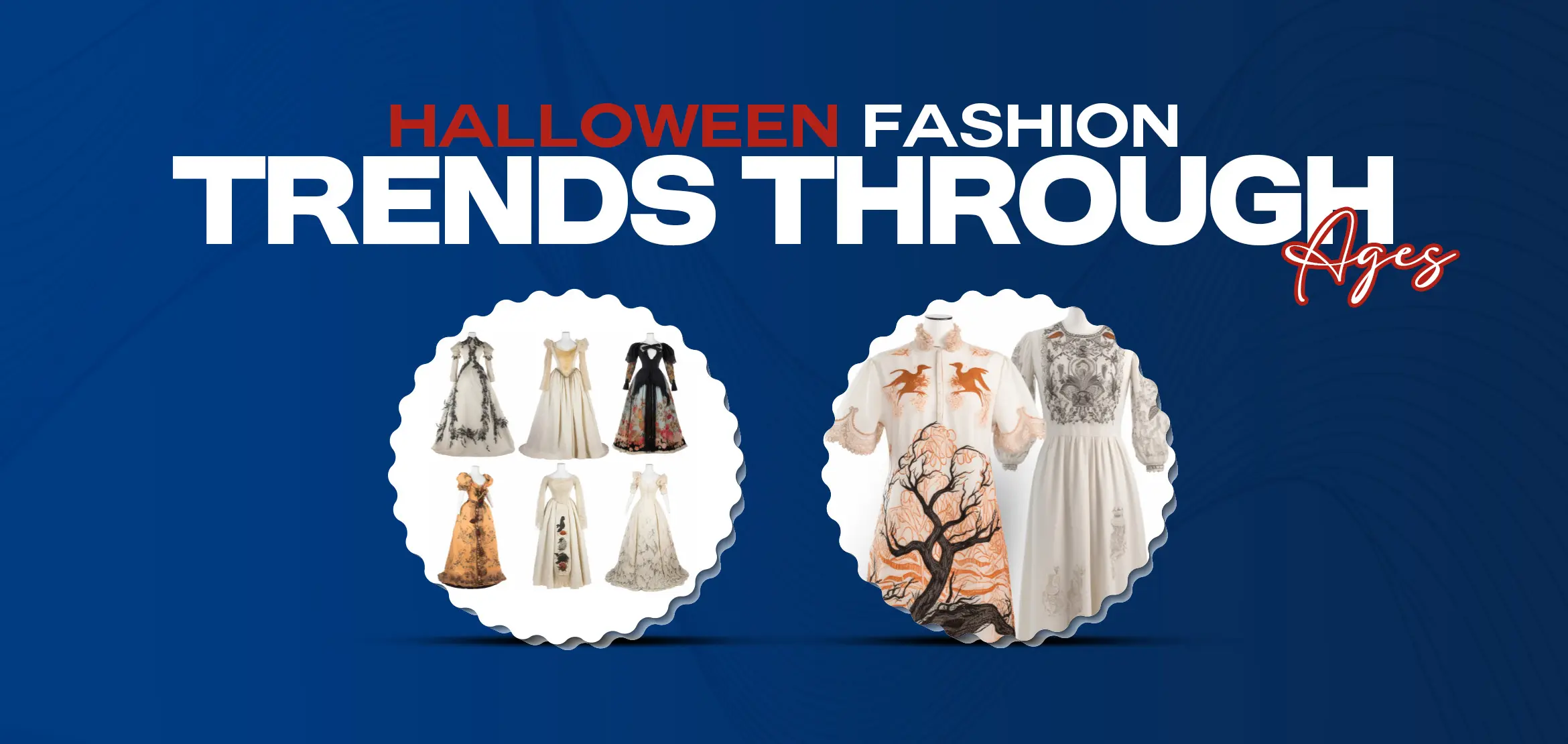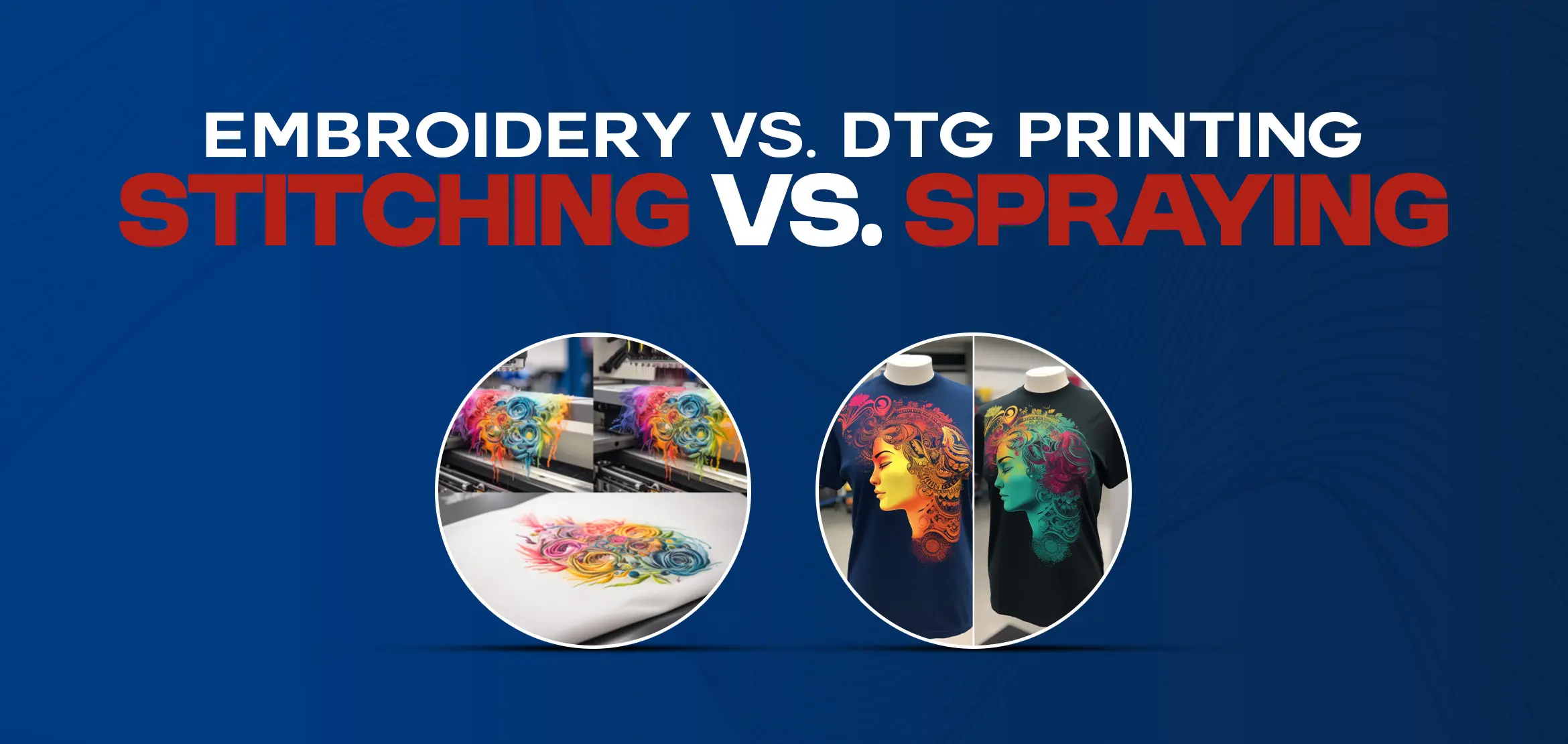
Embroidery vs. DTG Printing - Stitching vs. Spraying
Table Of Content
- 1. Advantages of Embroidery vs. DTG Printing
- 2. Advantages of DTG Printing vs. Embroidery
- 3. Types of Garments Suitable for Embroidery vs. DTG Printing
- 4. What Garments are Suitable for Embroidery vs. DTG Printing?
- 5. What Garments are Suitable for DTG Printing vs. Embroidery?
- 6. Quality Considerations
- 7. Quality of Embroidered Designs
- 8. Quality of DTG Printed Designs
- 9. Cost Comparison: Embroidery vs. DTG Printing
- 10. Cost Breakdown for Embroidered Designs
- 11. Cost Breakdown for Direct to Garment (DTG) Printed Designs
- 12. Factors That Influence the Price Differences Between Embroidery vs. DTG Printing
- Conclusion
- FAQs (Frequently Asked Questions)
Embroidery vs. DTG Printing (Direct-to-Garment) are two popular methods used for adding designs onto garments. While both techniques result in high-quality prints, there are some distinct differences between the two. Embroidery involves stitching threads onto fabric using an embroidery machine, creating intricate and detailed designs. It is a traditional and timeless decoration method that is often chosen for its durability and professional look. Particularly when it comes to embroidered logos. On the other hand, DTG printing uses inkjet technology to directly print designs onto fabrics. It allows for larger and more complex designs, and offers a wide range of color options with vibrant colors. DTG printing is known for its ability to produce photorealistic images and is particularly suitable for cotton blends. However, unlike embroidery vs. DTG printing does not involve setup time or incur extra costs for color variations. Ultimately, the choice between embroidery vs. DTG printing depends on the specific requirements of the project. The type of garment, budget, and personal preferences. Embroidery is a decoration method that offers numerous advantages over other techniques. One of the key benefits of embroidery is its durability. Unlike some printing methods, embroidery is resistant to fading and can withstand regular wear and tear. This makes it ideal for garments that will be frequently used or washed. In addition to its durability, embroidery also provides a professional appearance. The raised texture and intricate stitching add a touch of elegance to any design. Making it suitable for corporate or high-end branding. The three-dimensional aspect of embroidery creates depth and visual interest, enhancing the overall aesthetic of the finished product. Another advantage of embroidery is its long-lasting quality. This ancient method has been used for centuries and has stood the test of time. Embroidery can produce intricate designs with up to 7,500 stitches within one square inch, ensuring detailed and high-quality results. Overall, the advantages of embroidery lie in its durability, professional appearance, and long-lasting quality. Whether used for logos, monograms, or decorative designs, embroidery offers a timeless and elegant solution that can elevate any garment or accessory. DTG Printing, also known as Direct-to-Garment Printing, offers several advantages over traditional embroidery. One of the main advantages is speed. Unlike embroidery, which requires a time-consuming process of stitching each individual design onto the fabric. DTG Printing can quickly print a design directly onto the garment in a matter of minutes. This makes it an ideal choice for fast turnaround times or large orders. In addition to speed, DTG Printing also offers exceptional accuracy. Using inkjet technology, DTG printers can reproduce intricate design elements with utmost precision. This means that even the most detailed and complex designs can be accurately printed onto garments. The versatility of DTG Printing also allows for the printing of multiple colors on the same item. Creating vibrant and visually appealing designs. Furthermore, DTG Printing eliminates the need for setup time and additional costs associated with traditional embroidery. There are no mesh screens or embroidery machines required, making it a cost-effective option for printing services. DTG Printing also offers a wide range of color options, ensuring that designs can be printed onto various types of garments. Including cotton blends and other fabric materials. When it comes to choosing a decoration method for garments, it is important to consider the type of garment itself. Both embroidery vs. DTG printing have their own strengths and are suitable for different types of garments. Embroidery is a popular method for adding logos and designs onto fabrics, especially on traditional and high-quality garments. It adds a touch of elegance and sophistication to garments, and is commonly used on items such as dress shirts, blazers, and hats. On the other hand, DTG printing is a versatile option that is suitable for various types of garments, including t-shirts, hoodies, and other casual wear. Its inkjet technology allows for precise and detailed designs to be printed onto fabric, creating vibrant colors and visually appealing prints. Whether it's formal attire or a casual outfit. Both embroidery vs. DTG printing can provide excellent results depending on the type of garment and the desired effect. When it comes to embroidery, not all garments are created equal. The suitability of a garment for embroidery is often determined by its quality and thickness. Thicker and higher-quality garments, such as hoodies, polos, and sweatshirts, are ideal for embroidery. These types of garments provide a sturdy base for the embroidery stitches. Ensuring that the design stays in place and maintains its shape over time. Embroidery adds a professional and long-lasting touch to uniforms and garments designed for durability. The intricate and detailed stitching creates a three-dimensional effect that can enhance the overall appearance and appeal of the garment. Choosing the right garment for embroidery is crucial to achieving the desired result. Thicker and higher-quality embroidery fabrics offer better stability for the embroidery stitches and can withstand the wear and tear of regular use. Whether it's a logo on a polo shirt or a name on a hoodie, embroidery adds a touch of sophistication and permanence to any garment. When it comes to Direct-to-Garment (DTG) printing, certain types of garments are more suitable than others. While DTG printing can work on a variety of fabrics, it is primarily ideal for 100% cotton or cotton-blend fabrics. This is because the ink used in DTG printing adheres best to these types of materials. Resulting in vibrant and long-lasting prints. T-shirts are one of the most popular types of garments for DTG printing. Their smooth and flat surface provides an ideal canvas for high-quality prints. The versatility of t-shirts also allows for a wide range of designs and color options. Making them a go-to choice for personalized clothing. Hoodies are another favorite for DTG printing. The thicker fabric of hoodies allows for bold and eye-catching designs. Whether it's a custom logo or a unique artwork. DTG printing can easily transfer intricate details onto hoodies, creating a standout finished product. Aprons are also suitable for DTG printing, especially for businesses in the hospitality or food industry. DTG printing can accurately reproduce logos, names, or any other design onto aprons. Adding a professional and personalized touch to the garment. When it comes to choosing between embroidery and DTG printing, it's important to consider the quality of the finished product. Both methods have their own strengths and considerations when it comes to achieving high-quality results. Embroidery is known for its durability and classic look. The use of thread and stitching creates a textured and three-dimensional effect, particularly suitable for embroidered logos or designs. The detail and precision achieved with embroidery can elevate the overall look and feel of garments, especially for more traditional or formal apparel. On the other hand, DTG printing offers vibrant colors and intricate details that can be difficult to achieve with embroidery. DTG printing uses inkjet technology to transfer designs directly onto fabric, allowing for a wide range of colors and gradients. This makes it the ideal choice for complex or highly detailed designs that may not be easily achieved through embroidery. Ultimately, the choice between embroidery vs. DTG printing will depend on the specific requirements of your design. The type of garment, and the overall look and feel you want to achieve. Both methods offer their own unique advantages in terms of quality. So it's essential to carefully consider these factors before making a decision. One of the key qualities that sets embroidered designs apart is their tactile and three-dimensional elements. Unlike other printing methods, embroidery uses thread and stitching to create textures and depth in the design. This not only adds visual interest but also enhances the overall feel of the garment. Another notable aspect of embroidered designs is their long-lasting durability. The stitching ensures that the design remains intact even after multiple washes and wears. This makes embroidery a popular choice for items that require frequent use. Such as work uniforms or sports apparel. When assessing the quality of embroidered designs, there are a few factors to consider. The intricacy of the design plays a crucial role. Embroidery excels in capturing fine details and complex patterns with precision. However, it is important to note that embroidery is limited in terms of color blending options. Achieving gradients or smooth transitions between colors can be challenging with this method. Embroidery has a rich history, with its origins dating back thousands of years. It was initially done by hand and was an intricate and time-consuming process. In the 19th century, machine embroidery was introduced, revolutionizing the industry and making it more accessible. Today, modern embroidery machines can create intricate designs quickly and efficiently. DTG printing, also known as direct to garment printing, is a modern printing method that offers exceptional quality in printed designs. With advancements in inkjet technology, DTG printing produces high-resolution designs with improved accuracy and intricate design elements. One of the significant advantages of DTG printing is its ability to use multiple colors on the same item. This makes it ideal for creating vibrant and detailed designs that are visually stunning. Unlike screen printing, which requires a separate mesh screen for each color. DTG printing utilizes specialized printers that can precisely apply ink onto fabric. Resulting in a more versatile color palette. In addition to its impressive design capabilities, DTG printing is also a more sustainable option compared to traditional screen printing. This printing method eliminates the need for excess ink and reduces textile waste. As it only uses the necessary amount of ink for each design. This helps to minimize the environmental impact and promote sustainability in the garment printing industry. When it comes to selecting the right decoration method for your garments, cost is a crucial consideration. Both embroidery vs. DTG printing offers unique benefits, but they also come with different price tags. In this section, we will compare the cost factors associated with embroidery vs. DTG printing to help you make an informed decision for your garment printing needs. Embroidery often involves larger setups and upfront costs compared to DTG printing. Embroidery machines and digitizing software can be quite expensive. Making it a significant investment for businesses. Additionally, complex or intricate designs may require extra time and effort, resulting in higher labor costs. On the other hand, DTG printing eliminates the need for screen setups and intricate machine adjustments. Making it a more cost-effective option for small quantities and intricate designs. While embroidery may be a better choice for simple designs and large production runs. DTG printing can be a more affordable solution for smaller-scale projects. It is important to consider any potential additional costs associated with these printing methods. Embroidery typically requires the purchase of thread and backing materials. Which can add to the overall expense. DTG printing, on the other hand, may require pre-treating the garments with a special solution before printing. Which can increase the cost per item. Factor in these additional costs when comparing the overall expenses of embroidery vs. DTG printing. It is worth noting that the cost comparison between embroidery and DTG printing can vary depending on the type of garment and the complexity of the design. It is essential to consider your specific needs and budget constraints to determine the most cost-effective decoration method for your project. When it comes to the cost breakdown for embroidered designs, there are a few key factors to consider. Firstly, there is usually a one-time set-up fee, which can range from around £9.99. This fee covers the time and effort required to set up the embroidery machine and program the design into the digitizing software. In addition to the set-up fee, there may be additional costs associated with embroidery. One major factor is the number of stitches in the design. Each stitch requires time and thread, so the more stitches in a design, the higher the embroidery cost. Complex or intricate designs with a high stitch count can significantly increase the overall expense of the embroidery. The complexity of the design itself also contributes to the cost. Intricate or detailed designs require more time and skill to embroider, leading to higher labor costs. Designs with small details or numerous color changes can take longer to complete, resulting in additional charges. One important consideration when choosing embroidery is durability. Embroidery is known for its long-lasting quality and the ability to withstand multiple washes without fading or peeling. While the initial cost of embroidery may be higher compared to printing, the durability of embroidered designs can be a cost-saving factor in the long run. When considering the cost breakdown for Direct to Garment (DTG) printed designs. There are several factors that contribute to the overall cost. The upfront costs of DTG printing include the initial investment in the DTG printer itself. Which can range from a few thousand dollars to tens of thousands of dollars depending on the model and features. Additionally, there may be costs associated with purchasing software, pretreatment solutions, and other supplies. The cost per print is another key factor to consider. DTG printers use inkjet technology to print designs directly onto garments. The cost of the ink and other consumables, such as pretreatment solution and maintenance supplies, can vary depending on the brand and quality. The cost per print can also be influenced by the size and complexity of the design. Larger and more intricate designs may require more ink and time, resulting in higher costs. In addition to the upfront costs and cost per print, there may be additional expenses associated with DTG printing. This includes regular maintenance and replacement of printheads. As well as the need for a dedicated workspace and proper ventilation to ensure safety and optimal printing conditions. The price differences between embroidery vs. DTG printing can be influenced by several factors. One key factor in determining the price of embroidery is the number of stitches in the design. Embroidery machines use threads to create intricate designs by sewing stitches onto the fabric. The more stitches required, the more time and labor-intensive the process becomes, resulting in a higher price. On the other hand, the price of DTG printing is influenced by the number of colors in the design. DTG printers use inkjet technology to print designs directly onto garments. Each color requires a separate ink cartridge and printing process. Therefore, designs with more colors will require more time and resources, leading to a higher price. Additionally, the type of garment can also affect the price difference. Embroidery is well-suited for traditional embroidery logo designs on cotton fabrics or cotton blends, while DTG printing can be used on a wider range of materials. Both embroidery vs. DTG printing have their own advantages and considerations when it comes to pricing. Understanding these factors can help you choose the most cost-effective decoration method for your specific needs. In the realm of garment decoration, the choice between Embroidery and DTG Printing hinges on a nuanced understanding of their respective strengths and suitability for various projects. Embroidery, steeped in tradition, offers enduring durability and a sophisticated appearance. Its tactile, three-dimensional designs add a touch of elegance to garments, making it a prime choice for logos on high-quality clothing. In contrast, DTG Printing boasts speed and precision, ideal for fast turnarounds and intricate designs. With its vibrant colors and photorealistic capabilities, it's a go-to for cotton blends and casual wear. DTG Printing eliminates setup time and offers cost-effective color variations. Ultimately, the choice between these two techniques depends on your project's unique requirements, budget, and the type of garment. For professional and long-lasting elegance, embrace Embroidery. For intricate designs and swift turnarounds, harness the power of DTG Printing. For top-notch Embroidery Digitizing Services to bring your vision to life, reach out to us today! Explore our Embroidery Digitizing Services for unmatched garment decoration quality. Contact us now to bring your designs to life! Q1. What is the main difference between Embroidery and DTG Printing? Embroidery involves the meticulous stitching of threads onto fabric using specialized machines, resulting in textured and durable designs. On the other hand, DTG Printing employs inkjet technology to directly print intricate designs onto garments, offering a wide range of vibrant colors and highly detailed images. The choice between these methods depends on the specific requirements of your project. Q2. Which type of garments is best suited for Embroidery? Embroidery shines when applied to high-quality and traditional garments, such as dress shirts, blazers, and hats. It adds a touch of sophistication and permanence to these items, making it an excellent choice for businesses and individuals looking to make a lasting impression. Q3. What are the suitable garments for DTG Printing? DTG Printing is most effective on 100% cotton or cotton-blend fabrics. This printing method is particularly well-suited for t-shirts, hoodies, and aprons, allowing for the creation of vibrant and intricate designs. Whether it's formal attire or casual wear, DTG Printing can deliver striking results. Q4. How does the cost of Embroidery compare to DTG Printing? When it comes to cost, there are differences between the two methods. Embroidery requires upfront investments in machinery and digitizing, making it a more economical choice for larger production runs. In contrast, DTG Printing is cost-effective for smaller quantities and intricate designs, as it eliminates setup time and complex machinery, offering flexibility for various project sizes. Q5. What factors influence the pricing differences between Embroidery and DTG Printing? Pricing differences between Embroidery and DTG Printing can be attributed to several factors. In Embroidery, the number of stitches in the design plays a significant role in determining the price. More stitches mean more time and labor, impacting the overall cost. For DTG Printing, the number of colors in the design is a key cost factor. Complex, multi-colored designs require more ink and resources. Additionally, the type and quality of the garment can influence the price, making it essential to consider these factors when making your decoration choice.1. Advantages of Embroidery vs. DTG Printing
2. Advantages of DTG Printing vs. Embroidery
3. Types of Garments Suitable for Embroidery vs. DTG Printing
4. What Garments are Suitable for Embroidery vs. DTG Printing?
5. What Garments are Suitable for DTG Printing vs. Embroidery?
6. Quality Considerations
7. Quality of Embroidered Designs
8. Quality of DTG Printed Designs
9. Cost Comparison: Embroidery vs. DTG Printing
10. Cost Breakdown for Embroidered Designs
11. Cost Breakdown for Direct to Garment (DTG) Printed Designs
12. Factors That Influence the Price Differences Between Embroidery vs. DTG Printing
Conclusion
FAQs (Frequently Asked Questions)
